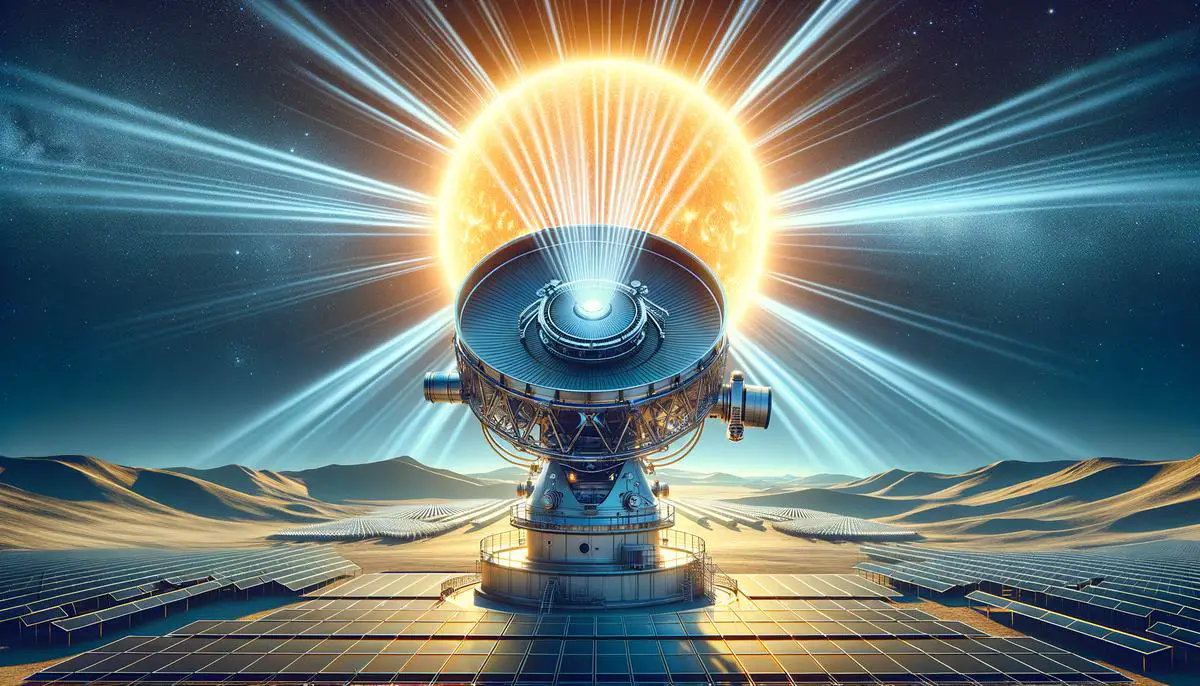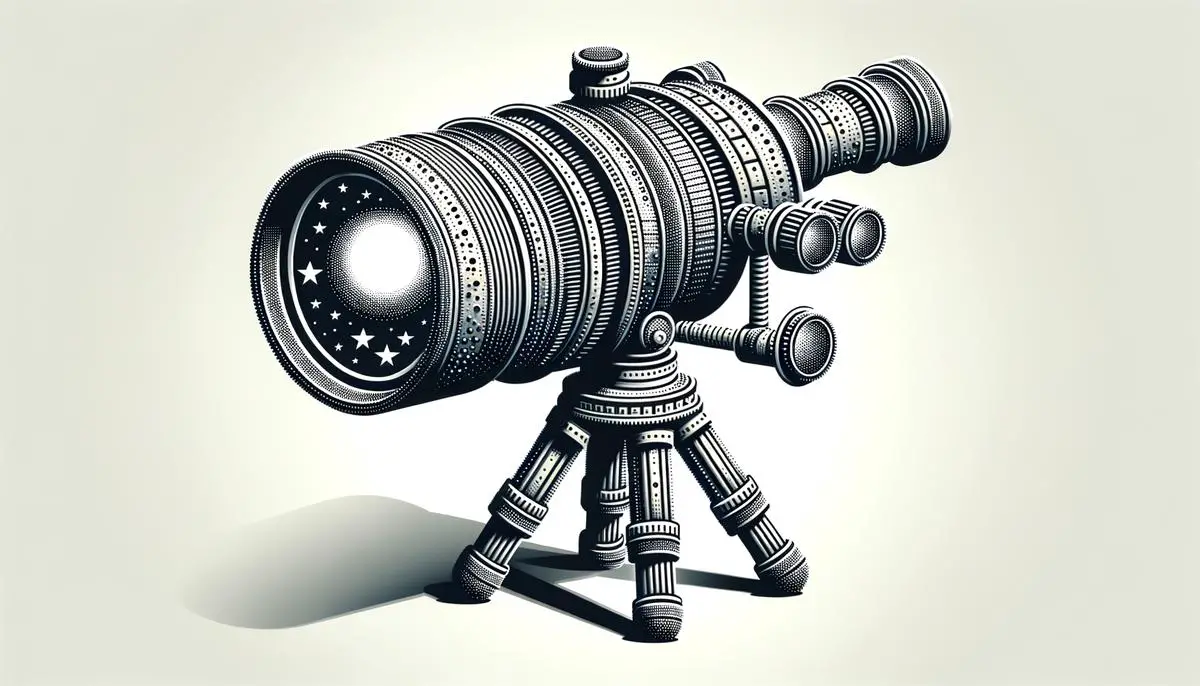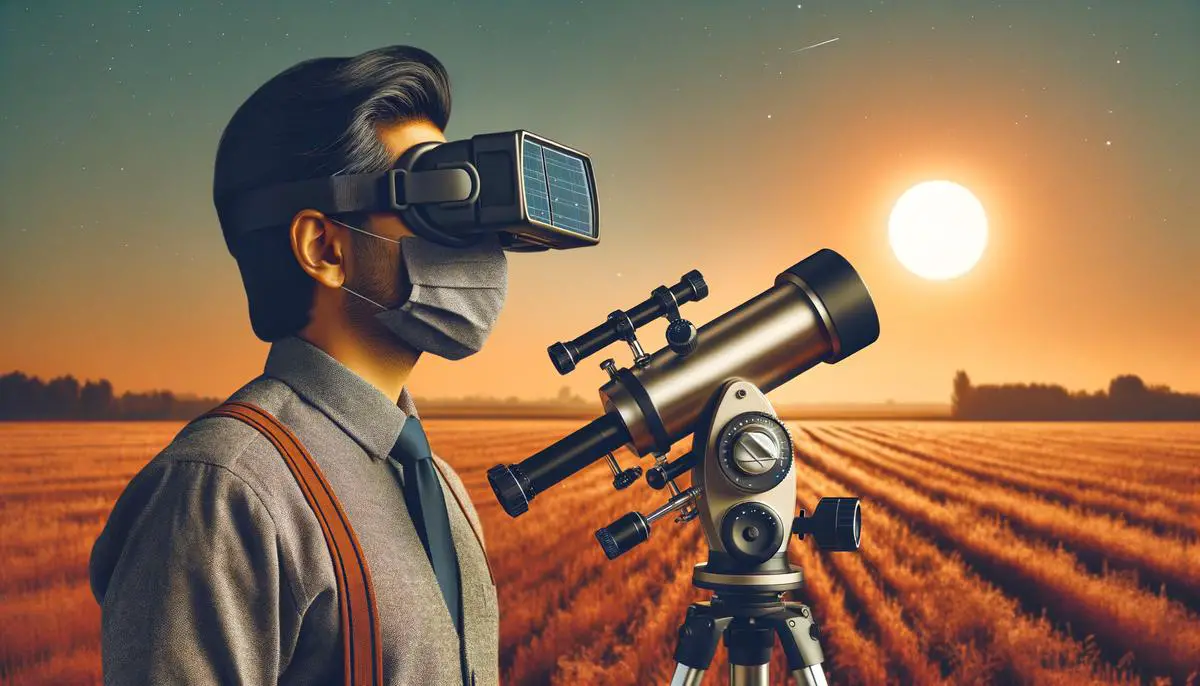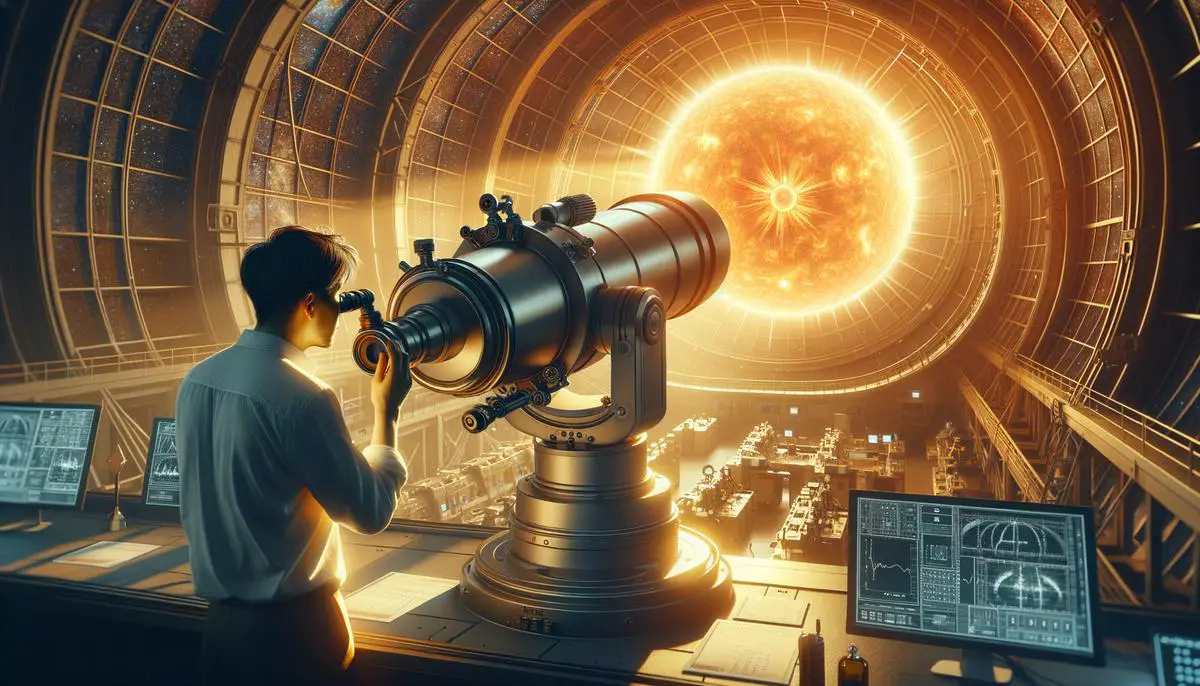Delving into the study of solar telescopes offers a window into the sophisticated techniques and technologies developed to observe our closest star, the sun. This journey through the capabilities and features of solar telescopes reveals the careful considerations and advancements that enable us to safely and effectively monitor solar phenomena. By examining the critical roles of filters, adaptive optics, and thermal management, alongside the importance of aperture size and filter types, we gain a comprehensive understanding of what makes solar telescopes indispensable tools in the field of astronomy.
Understanding Solar Telescopes
Solar telescopes possess filters that reduce the sun’s brightness to a level safe for observation and instrument sensors. These aren’t just any kind of filters; they’re advanced pieces, specially built to handle the intense solar radiation. Imagine wearing sunglasses, but these are like sunglasses on steroids, designed specifically to protect the telescope’s delicate “eyes.”
Moreover, adaptive optics play a crucial role in solar observation. Given the sun’s dynamic surface, full of solar flares and sunspots that change from one moment to the next, adaptive optics adjust in real-time. This technology corrects distortions caused by the Earth’s atmosphere, allowing for a crystal-clear view of the sun’s surface, much like smoothing out the ripples on a pond to see the rocks below clearly.
Another significant aspect is thermal management within solar telescopes. Observing the sun generates a lot of heat, which if not managed, could damage the telescope. This includes cooling systems that dissipate heat away from critical components. It’s akin to having a high-powered computer that needs fans to keep it from overheating; solar telescopes need their own version of a cooling system to protect their sensitive instruments.
Compared to other astronomical telescopes, solar telescopes operate under the harsh glare of our nearest star during the day. This necessitates robust protective measures, unlike those observatories peering into the cooler, gentler lights of distant stars and galaxies at night.
The daytime work also requires precise tracking systems to follow the sun across the sky accurately. Unlike other celestial bodies observed mostly in static night skies, observing the sun involves constant adjustment and recalibration to keep it in view as Earth rotates.
Each of these features highlights that solar telescopes are not just regular telescopes pointed at the sun. They are marvels of engineering, specially outfitted to tackle the unique challenges of solar observation—making sure we can safely unlock the secrets of our closest star.

Key Features of High-Quality Solar Telescopes
Shifting the focus slightly, it’s pivotal to acknowledge how the aperture size of a solar telescope significantly influences its ability to capture vivid, detailed images of the sun. A larger aperture collects more light, furnishing clearer and more intricate solar views, thus allowing astronomers to study sunspots, solar flares, and coronal mass ejections with superior clarity.
Discussing filters further, while Hydrogen-alpha (H-alpha) and Calcium-K are common, each serves a distinct purpose. H-alpha filters excel in revealing solar flares and prominences at the sun’s edge, engaging observers with an intimate view of solar activity. On the other hand, Calcium-K filters unearth the intricate layers of the sun’s atmosphere, showcasing magnetic activities and faculae with stunning definition.
Revisiting magnification, it’s vital to hit the sweet spot. While more magnification can bring objects closer, for solar viewing, one needs balanced magnification to maintain image brightness and clarity. This balance permits detailed observations of solar phenomena without compromising the image quality.
When discussing mount stability, remember, a sturdy mount is not just beneficial; it’s a necessity. The precision with which the telescope needs to track the continuously moving sun hinges largely on the stability of its mount. A robust mount minimizes vibrations, ensuring the fine details of the solar surface are not lost to blurriness.
Another non-negotiable attribute is a reliable solar filter, either built-in or as an add-on. This is the frontline defense against the intense solar radiation that can otherwise cause irreversible damage to both the observer’s eyesight and the telescope’s sensitive optics. These filters should be of high quality to ensure a safe viewing experience, effectively blocking harmful ultraviolet and infrared radiation while allowing safe wavelengths of light to pass through for observation.
Finally, besides these nuanced but crucial features, an often-overlooked aspect is ease of use and portability. For many users, these factors will dictate how frequently the telescope is used. A system that’s cumbersome or difficult to set up could end up collecting dust instead of solar data.
Each aspect from aperture size to portability plays a crucial role in shaping a memorable and productive solar observing experience. Thus, investing in a solar telescope that ticks all these boxes isn’t just about buying a piece of equipment; it’s about unlocking a door to the dynamic universe of solar astronomy.

Technological Advancements in Solar Observation
With the core elements of solar telescopes and their operation already discussed, let’s steer our focus toward the leap technology has taken to boost our understanding of the Sun through advancements not previously mentioned.
Recent years have seen a surge in technologically superior imaging systems capable of unveiling fine details on the solar surface.
Enter the high-resolution cameras, no ordinary tools, but marvels equipped with sensors that can capture the Sun’s features with unprecedented detail. These cameras, when coupled with the raw processing power of modern computing, allow for the manipulation and enhancement of solar images, peeling back layers of solar activity that were once blurred or entirely missed.
Shifting gears somewhat, the realm of spectroscopy has also welcomed significant progress. This advancement doesn’t just present us with pictures; it uncovers the story of solar material composition and behavior. Advanced spectrographs dissect the Sun’s light into its spectral lines with such clarity and detail that scientists can pinpoint elements, measure their abundance, and observe dynamic events like flares and eruptions in different layers of the Sun’s atmosphere.
All this technology wouldn’t be as effective if it weren’t for the adaptive optics’ continuous evolution. This system, which already played a part in earlier stages, now employs more sophisticated algorithms and faster actuators to correct atmospheric distortion in real-time. The outcome? Sharper images that bring the solar surface up close and personal, as though Earth’s turbulence-layer was entirely peeled away.
Portable solar telescopes have also made a splash in the field. These compact wonders make solar observing accessible not just to researchers at observatories but also to amateur astronomers and educational institutions. With portability comes the opportunity for rapid deployment during solar events, enabling observations from multiple locations to gather substantial data.
Combine all these advancements, and you get a comprehensive toolkit empowering astronomers to scrutinize the Sun across different wavelengths, magnifications, and environmental conditions. It marks an era where observing our closest star doesn’t just mean seeing light and dark spots move across its surface but understanding the profound processes fueling our cosmic lantern. As we peel away each layer of technology, it’s as though we’re peeling an onion, uncovering layers of complexity and beauty in solar observation that continue to challenge and inspire the astronomy community.

Safety Considerations When Observing the Sun
When stepping into the world of solar observation, it’s critical to acknowledge the power of the sun and the absolute necessity of your security. Without understating it, staring directly into the sun, even through a telescope that lacks proper solar protection, is akin to opening the door to irreversible eye damage. The process begins with knowing when and how to use solar viewing glasses. These are not your average sunglasses but are specifically crafted to filter out harmful UV and IR radiation, making it safe to look at the sun directly. These glasses are essential, not just for casual viewing but also during the setup phase of your solar telescope, ensuring you don’t accidentally catch a glimpse of unfiltered sunlight.
Understanding and applying correct solar filter placement is another cornerstone of safe solar observation. While the body of knowledge on adaptive optics and thermal management of solar telescopes is expanding, it’s the actual placement of solar filters that acts as the first line of defense. Before any observation begins, ensure your solar filter is firmly attached to the telescope’s front end, acting as a shield by blocking out the majority of sunlight before it even enters the optical system. This step cannot be overstated in its importance—it’s essentially what allows observers to watch the sun without harm.
Yet, knowing that equipment alone cannot guarantee safety, observing proper procedures and having a checklist can make a world of difference. Begin each session with a visual inspection of both the hardware and software components of your setup. Check for any damages to your solar filter and ensure your telescope’s software, if any, like tracking systems are updated and properly configured. It’s easy to underestimate the importance of these pre-observation rituals, but they are essential for secure viewing.
Even with all precautions in place, awareness while observing is key. Constantly monitor the condition of your equipment throughout the viewing process. If you have an electronic display connected to a camera for direct solar imaging, give preference to viewing the sun through this method rather than through an eyepiece. This not only provides a layer of safety but also opens up new possibilities for capturing images without direct exposure.
For educators and astronomy club members who facilitate group observations, instilling these safety measures in all participants becomes doubly important. Create a standardized orientation or guide that addresses the safe setup and use of solar telescopes. This effort educates everyone on not just how to use the telescopes, but how to do so responsibly and securely.
Exploring the universe’s power source, our sun, is fascinating and holds the keys to countless mysteries awaiting unraveling by intrepid observers. However, it commands a level of respect and caution, hinged on comprehensive safety protocols that ensure our quest for knowledge does not come at the expense of our well-being. Armed with the right tools and knowledge, assuredly, we stand on the brink of discoveries not just about our celestial neighbor but also about responsible observation and engagement with the cosmos.

Case Studies: Top Solar Telescopes in Action
The Daniel K. Inouye Solar Telescope, situated atop Haleakalā on the island of Maui, Hawaii, has emerged as a colossus in the field of solar observation. Its primary mirror, boasting a diameter of 4 meters, is the largest of any solar telescope. This gigantic aperture enables it to capture images of the sun with unparalleled clarity and detail, allowing scientists to study solar phenomena like never before. For example, it has provided the most detailed images yet of the sun’s surface, revealing the turbulent “boiling” motion of plasma that covers the entire sun. This movement is key to understanding solar convection and magnetic fields.
The Solar Dynamics Observatory (SDO), launched into orbit around the Earth in 2010, offers a different vantage point for observing our star. Equipped with a suite of instruments, this observatory can monitor the sun in multiple wavelengths simultaneously. The SDO has been instrumental in uncovering how magnetic energy is stored and released in the sun’s atmosphere. These discoveries are crucial for understanding and predicting solar flares and coronal mass ejections, which can have significant impacts on Earth’s space weather, potentially affecting satellites, power grids, and communications networks.
Both telescopes have played pivotal roles in advancing our knowledge of the sun’s magnetic field. The Inouye Solar Telescope, with its superior resolving power, can observe magnetic fields at smaller scales than ever before, showing us how they contribute to the incredibly dynamic nature of the solar surface and atmosphere. Meanwhile, The SDO’s comprehensive view of the sun in different wavelengths has revealed how these magnetic fields evolve on larger scales and over time, leading to major solar events like flares and coronal mass ejections.
One significant discovery involves the intricate structure of sunspots, dark spots on the sun’s surface where magnetic fields are intensely concentrated. These areas are cooler than the surrounding plasma, making them appear dark in contrast. Thanks to these telescopes, we now understand much more about the formation of sunspots and their lifecycle, which in turn helps us to predict solar activity and its effects on Earth.
Additionally, these observatories have shed light on the process of solar flares and coronal mass ejections. By tracking these events from their initial magnetic instabilities to their explosive release of energy, scientists are starting to piece together the complex puzzle of solar dynamics. This knowledge not only expands our understanding of the sun but also enhances our ability to forecast potentially disruptive space weather events.
Through the combined efforts of facilities like the Daniel K. Inouye Solar Telescope and the Solar Dynamics Observatory, we are jumping ahead in our quest to comprehend the sun’s intricate behaviors. Each observation made by these telescopes contributes valuable pieces to the grand puzzle of our star, bringing us closer to unlocking the mysteries that have captivated humanity for centuries.

In conclusion, the essence of solar observation lies not just in the equipment used but in the intricate dance of technology and safety measures that allow us to witness the sun’s majesty without harm. The marvels of engineering behind solar telescopes, from their sophisticated filters to their advanced cooling systems, underscore the importance of these instruments in our ongoing quest to comprehend the sun’s complex behaviors. As we continue to harness these technologies, we edge closer to unraveling the mysteries of our star, ensuring that our fascination with the cosmos is matched by our commitment to observation safety.
![]()
